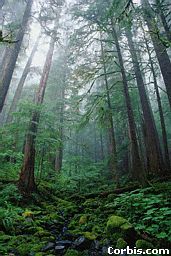
Rainfall
Rain forests can average as little as 6 ft. or as much as 30 ft., of rainfall a year. What distinguishes a true rain forest is the distribution of precipitation throughout the year, this means there are no dry seasons. Every month, more than 4in. of rain falls. If a rain forest does have dry periods, they are usually short and unpredictable. In many climates, rainfall evaporation is carried away to fall as rain in distant places, but in the rain forests, nearly 50 percent of the precipitation comes from local evaporation. The warm, humid air surrounding a rain forest forms a microenvironment that permits little water to escape. Much of the rain that falls on the rain forest is intercepted by the trees in the canopy. Some of it rolls off the leaves and down the trunks to the forest below, but a high percentage evaporates and hangs as tiny droplets of water in the humid atmosphere. Gentle and continuous winds lift the tiny droplets higher in the atmosphere, where they cool and form clouds. When enough of these drops enter the atmosphere and cool, they condense and fall as rain, beginning the cycle again.
Soil
When we think of soil and the rain forests, we think of fertile soil. Soil in the rain forest is poor in nutrients that can be absorbed by plant roots. The nutritious minerals have been washed out of the soils by heavy rainfall and high temperatures over thousands of years. To compensate for the nutrient poor rain forest soils, most tropical trees absorb the nutrients they can find and hold them in their living tissue. In contrast, the rich soils of temperate forests are better able to retain nutrients, enabling a temperate forest tree to absorb small amounts of minerals as the tree needs them. When tropical trees die, nutrients are released into the soils by decomposition. Rather than remaining in the soil reservoir as they would in a temperate forest, in the rain forest, the nutrients are rapidly absorbed again by other living organisms.

|




